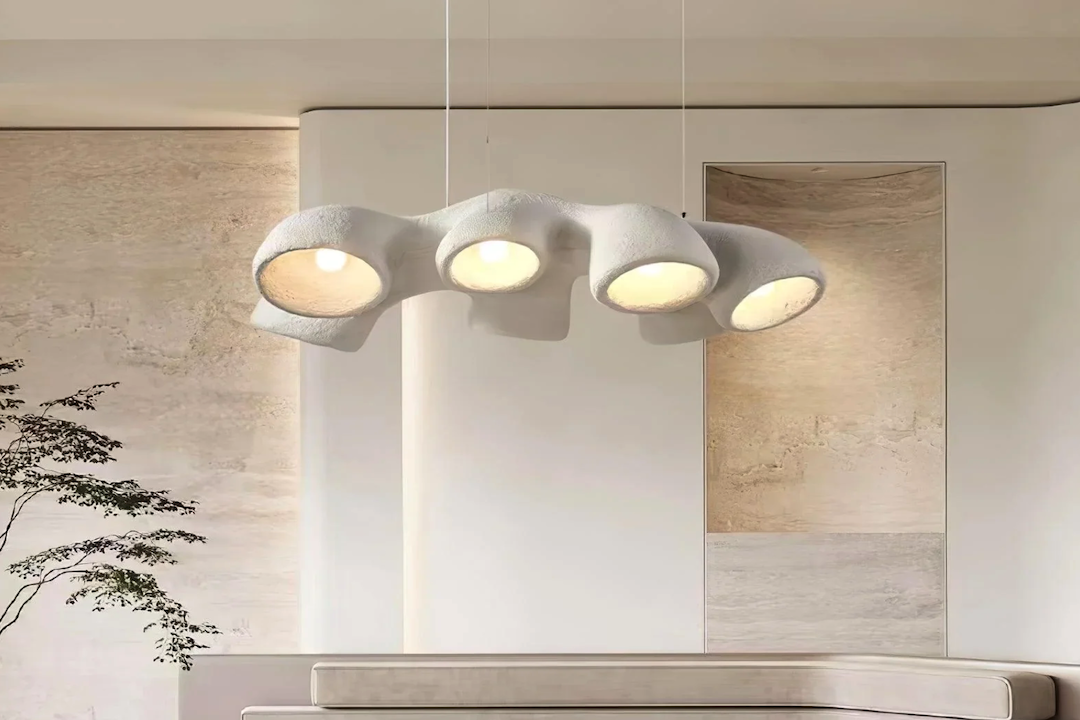Embracing Imperfection: The Creative Wabi-Sabi Chandelier

Embracing Imperfection: The Creative Wabi-Sabi Chandelier
Wabi-sabi is a Japanese aesthetic philosophy that celebrates the beauty found in imperfection, transience, and the natural cycle of growth and decay. Rooted in Zen Buddhism, this concept encourages individuals to appreciate the fleeting nature of life and the unique characteristics that arise from wear and age. Unlike Western ideals that often prioritize perfection, symmetry, and uniformity, wabi-sabi invites us to embrace the irregularities and asymmetries that make objects and experiences truly unique.
This perspective can be seen in various aspects of Japanese culture, from traditional tea ceremonies to the art of pottery, where the beauty of a cracked bowl or a weathered surface tells a story of its journey through time. The essence of wabi-sabi lies in its ability to evoke a sense of tranquility and acceptance. It teaches us to find beauty in the mundane and to appreciate the simple joys that life offers.
For instance, a rustic wooden table with knots and imperfections can evoke warmth and character, serving as a reminder of the tree’s life before it became furniture. This philosophy encourages mindfulness, urging us to slow down and observe the world around us, recognizing that beauty often resides in the overlooked details. By embracing wabi-sabi, we cultivate a deeper connection with our surroundings and foster an appreciation for the transient nature of existence.
Embracing Flaws: How Wabi-Sabi Philosophy Inspires Creativity
The wabi-sabi philosophy serves as a powerful catalyst for creativity, encouraging artists, designers, and creators to explore unconventional ideas and materials. By embracing flaws and imperfections, individuals are liberated from the constraints of traditional aesthetics that often dictate what is considered beautiful or valuable. This freedom allows for experimentation and innovation, leading to unique creations that resonate on a deeper emotional level.
For example, an artist might choose to incorporate found objects or materials with visible wear into their work, celebrating their history rather than concealing it. In the realm of design, wabi-sabi inspires a shift towards sustainability and authenticity. Designers are increasingly drawn to materials that tell a story—reclaimed wood, hand-thrown ceramics, or textiles with irregular patterns.
These choices not only reflect a commitment to environmental consciousness but also infuse spaces with character and depth. The process of creating with wabi-sabi in mind often involves a willingness to accept mistakes as part of the journey. A misaligned seam in a handmade garment or an uneven glaze on pottery can become focal points that highlight the human touch behind the creation, inviting viewers to appreciate the artistry involved.
The Wabi-Sabi Chandelier: A Unique Blend of Elegance and Imperfection
The wabi-sabi chandelier Fiveasia embodies the philosophy’s core principles by merging elegance with imperfection. Unlike traditional chandeliers that often emphasize opulence and symmetry, a wabi-sabi chandelier embraces asymmetry and organic forms. Crafted from natural materials such as driftwood, metal with patina, or hand-blown glass, these fixtures reflect the beauty of nature’s imperfections.
Each piece becomes a conversation starter, drawing attention not only to its function as a light source but also to its artistic expression. One striking example of a wabi-sabi chandelier is one made from reclaimed materials, where each component carries its own history. A chandelier constructed from salvaged barn wood paired with vintage glass globes creates a stunning visual contrast that highlights both rustic charm and refined elegance.
The interplay between rough textures and delicate light creates an atmosphere that is both inviting and contemplative. Such designs challenge conventional notions of luxury by prioritizing authenticity over extravagance, allowing homeowners to express their individuality through unique lighting choices.
Finding Harmony in the Unfinished: The Art of Creating Wabi-Sabi Chandeliers
Creating wabi-sabi chandeliers involves an artistic process that values the unfinished and the raw. This approach encourages artisans to leave elements intentionally unrefined or incomplete, allowing viewers to engage with the piece on a deeper level. For instance, an artisan might choose to leave visible tool marks on metal components or allow wood to retain its natural grain and knots.
These choices not only celebrate the material’s inherent qualities but also invite contemplation about the journey of creation itself. The art of crafting wabi-sabi chandeliers also emphasizes balance and harmony within asymmetry. A well-designed chandelier may feature an uneven arrangement of light sources or an organic shape that mimics natural forms like branches or flowers.
This intentional imbalance creates visual interest while maintaining an overall sense of unity. The result is a piece that feels alive and dynamic, reflecting the ever-changing nature of life itself. By embracing the unfinished aspects of design, artisans create chandeliers that resonate with authenticity and invite viewers to appreciate the beauty found in imperfection.
Embracing Natural Materials: The Role of Organic Elements in Wabi-Sabi Design
Natural materials play a pivotal role in wabi-sabi design, serving as conduits for expressing the philosophy’s core tenets. Wood, stone, clay, and metal are often favored for their tactile qualities and inherent imperfections. Each material carries its own narrative—wood may reveal knots and grain patterns shaped by years of growth, while stone may exhibit variations in color and texture due to geological processes.
By incorporating these organic elements into design, creators celebrate the uniqueness of each piece while fostering a connection to nature. In the context of chandeliers, natural materials can transform lighting fixtures into works of art that resonate with their surroundings. A chandelier crafted from driftwood not only showcases the beauty of weathered wood but also evokes memories of coastal landscapes and serene moments by the sea.
Similarly, incorporating hand-blown glass elements allows for variations in color and form that reflect the artisan’s touch. These organic materials not only enhance aesthetic appeal but also contribute to a sense of grounding within interior spaces, reminding us of our connection to the natural world.
The Timeless Appeal of Wabi-Sabi: How Imperfect Design Transcends Trends
Wabi-sabi’s timeless appeal lies in its ability to transcend fleeting design trends by focusing on authenticity rather than superficial aesthetics. In an era where fast fashion and mass production dominate many industries, wabi-sabi offers an antidote by promoting slow craftsmanship and thoughtful design choices. This philosophy encourages individuals to invest in pieces that resonate with their values and experiences rather than succumbing to the pressures of consumerism.
The enduring nature of wabi-sabi can be seen in its resurgence within contemporary design circles. As people seek more meaningful connections with their environments, they are drawn to pieces that tell stories—whether through their materials, craftsmanship, or imperfections. A wabi-sabi chandelier becomes more than just a source of light; it transforms into a symbol of individuality and authenticity within a space.
By embracing this philosophy, individuals create homes that reflect their personalities while fostering an atmosphere of comfort and serenity.
The Wabi-Sabi Aesthetic: Creating a Tranquil and Serene Atmosphere with Chandeliers
The wabi-sabi aesthetic is characterized by its ability to create tranquil and serene environments that promote mindfulness and reflection. Chandeliers designed with this philosophy in mind contribute significantly to this atmosphere by providing soft illumination that enhances rather than overwhelms a space. The gentle glow emitted from organic materials creates an inviting ambiance that encourages relaxation and contemplation.
Incorporating wabi-sabi chandeliers into interior design can transform ordinary spaces into sanctuaries of peace. For instance, a living room adorned with a handcrafted chandelier made from reclaimed wood can evoke feelings of warmth and comfort while serving as a focal point for gatherings. The interplay between light and shadow created by such fixtures adds depth to the room, inviting occupants to slow down and appreciate their surroundings.
This serene atmosphere aligns perfectly with the principles of wabi-sabi, fostering an environment where individuals can connect with themselves and others on a deeper level.
Embracing Imperfection in Your Home: Incorporating Wabi-Sabi Chandeliers into Your Decor
Incorporating wabi-sabi chandeliers into your home decor is an invitation to embrace imperfection as a source of beauty and inspiration. To begin this journey, consider selecting pieces that resonate with your personal style while reflecting the principles of wabi-sabi—look for chandeliers crafted from natural materials with unique textures or asymmetrical designs that evoke a sense of organic flow. When integrating these fixtures into your decor, think about how they interact with other elements in your space.
A wabi-sabi chandelier can serve as a stunning centerpiece above a rustic dining table or as an eye-catching accent in an entryway. Pairing it with complementary decor—such as handmade ceramics or textiles featuring irregular patterns—can enhance the overall aesthetic while reinforcing the theme of authenticity throughout your home. Ultimately, embracing wabi-sabi chandeliers allows you to create spaces that celebrate individuality and foster connections with both nature and those who inhabit them.
By surrounding yourself with pieces that embody this philosophy, you cultivate an environment where imperfections are cherished, stories are shared, and beauty is found in every moment.
